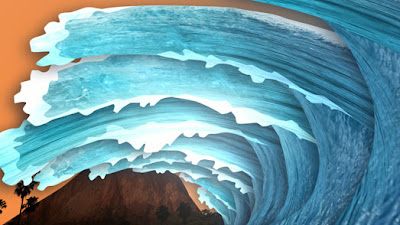Mentor: Kathy Smith
My intention was to research and explore expanded multi-media formats and new ways of presenting animated imagery that would support my thesis development. I concentrated my creative research interests on the following areas:
XSI/ 3D Animation
Mentor: Daniel Robichard
Practical development of news 3D skills and tools directly related to imagery I want to use in my thesis
Some Topics Covered:
Digital Slide Projector, Intermediate Shape Animation, More In-Depth study of lights & shadows, Displacement Maps & Extruding Polygons from B x W Images, Extruding Shapes from Vector Paths, Texture Layers, Basic Dynamics, 3D Cut-Out Animation, Exporting Camera Data to After Effects, Working with External Models, & much more. Working with Daniel was an amazing help!
AFTER EFFECTS/ Plug-ins, Filters
Mentor: Michael Patterson
I've been exploring how to create surface distortions of animated imagery to achieve a variety of lens and format effects. For thesis, I want to simulate the look of old film, hi-8 video, VHS video, HD, and looking through various lenses like a telescope. Mike Patterson suggested various effects and filters to help me give an old film* effect to my stop-motion project for his class last semester. Eric Furie helped me download these plug-ins. I was also able to experiment with a variety of old video effects for another current project*.
STEREOSCOPY/ Anaglyph
Mentors: Perry Hoberman, Lara Banks, John Helton
I am interested in making my thesis stereoscopic. Therefore, in preparation, I wanted to start researching and working with this technology now. Perry Hoberman assisted with my initial research into Stereoscopy last semester. See our website here:
I took Perry's workshop on creating Stereoscopic Images at the USC Interactive Media Lab this semester. This provided enough information for me to begin working with the Red/Cyan Stereoscopic Process. I developed an animated stereoscopic installation for Lara Banks' Brigade Parade gallery show as part of our CTAN 501 class.

I am glad that I started working with Stereoscopy now. It gave me a good taste of what it is really like to consider the "Z" plane, how shots need to be designed to truly play with depth, how this might be utilized to affect the psychology of the shot, and just how much more technical tinkering and obsessive rendering it takes! It also demonstrated the limitations of working with anaglyph stereoscopy. Color is really important to my work. If I do indeed take this on for thesis, I definitely want to work with polarized projection!
RESEARCH (beyond faculty instruction)
Web, book, & magazine based
Much of this is already documented on other blogs I've been keeping. However, I wanted to highlight some of my interesting "finds" throughout the semester on this blog as future reference. I have been researching what other animation artists are doing to push the medium of animation into expanded conceptual, visual, & media formats.
As it relates to my own work, I have been most interested in uncovering work which displays a connection between organic and digitally created work. I am curious about how this hybrid approach is being achieved regardless of whether or not the media is actually "organic" or "digital". Rather, how do artists utilize the best of both worlds?
Additionally, I have been curious about what the term "interactive" means and whether or not it would really be necessary for me to use new media interactive technology as the basic functional design of my thesis. To that end, I visited USC's Interactive Media Department. Kurosh ValaNejad gave Deborah Allison and I a thorough tour of the department and showed us current Game Media Lab research projects. I also spoke with current Interactive MFA (and recent Grad) students about the plausibility of designing my project to be interactive. Perry Hoberman recommended taking advantage of the Unity Game Engine. I might experiment with this during his Stereoscopy class I am enrolled in for Fall 2008.
In the mean-time, through this research, I concluded that tackling the technical challenges of creating an interactive thesis is beyond what I hope to accomplish as an Animation MFA student. I feel that the learning curve would take away from focusing more energy on the conceptual and visual design of the project. For now, I will concentrate on the ways in which a director can design animated projects to be interactive and immersive in psychologically engaging ways, regardless of whether or not the viewer is directly informing the outcome of the experience! In the future, I will definitely consider collaborating and experimenting more directly with interactive design.
Overall, participating in this Directed Study has allowed me to extend and expand my research interests beyond the scope of my other classes in ways which have directly informed and supported my thesis development.
.jpg)


_1.jpg)




.jpg)
.jpg)
.jpg)
.jpg)
.jpg)




.jpg)
.jpg)























.jpg)
.jpg)
.jpg)
.jpg)
.jpg)


